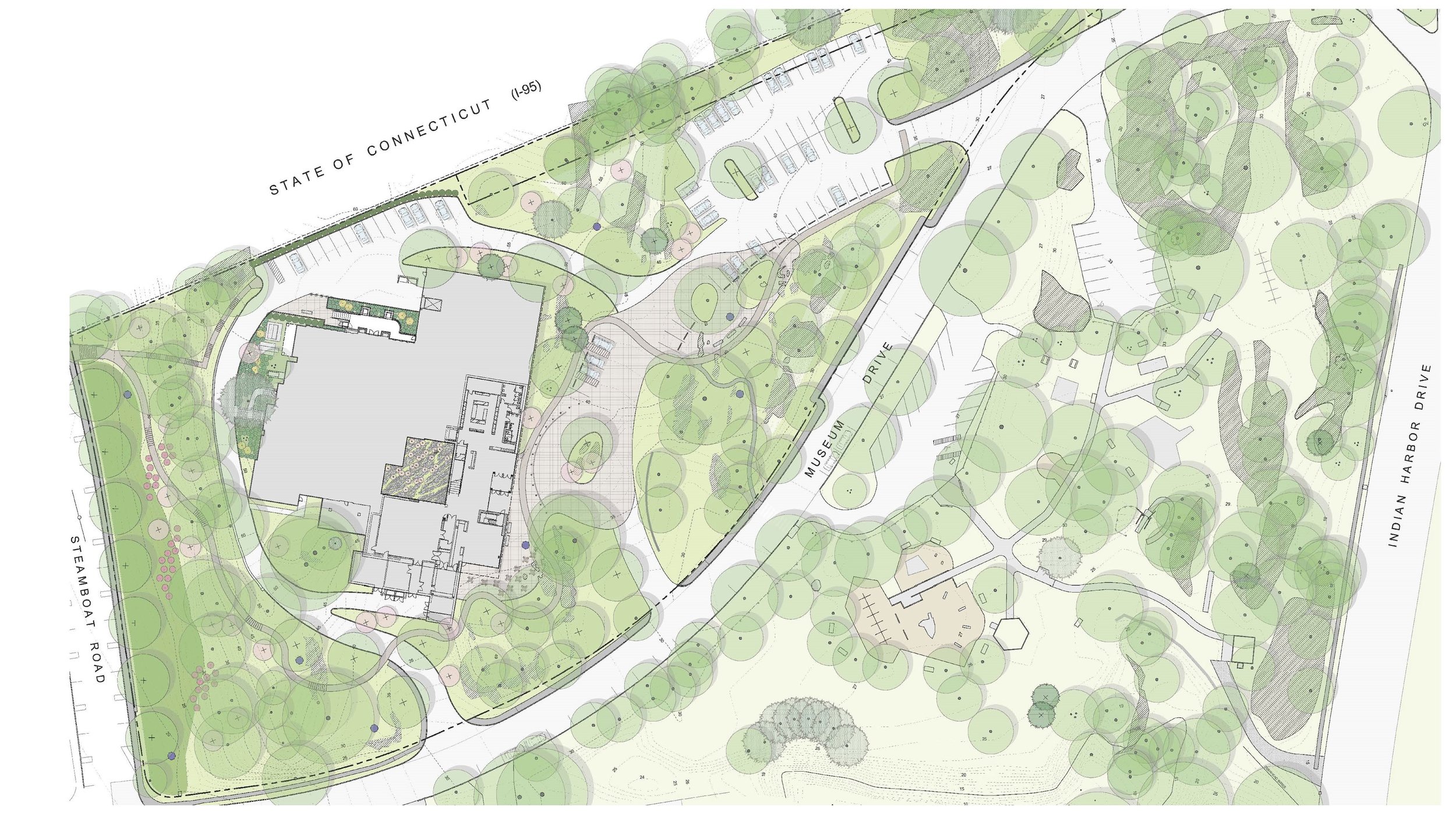Building Architect
Our approach to design seeks to concentrate the unique experience of a given context—be it physical, cultural and/or social—in ways that reveal the extraordinary in the ordinary. In this manner, we believe that architecture—as does art—can play a profound and potent role in shaping how we experience the world around us. Inspired by our experience exploring granite quarries in Guilford and Stony Creek along the Connecticut coast, the Bruce Museum draws inspiration from geology, a subject that has a rich history of scientific and technical exploration that has inspired many artists. The Bruce is conceived of as a stone monolith that is carved and excavated to create a monument that celebrates the geology of the site and its impact in shaping the culture of Connecticut, as well as creating a repository for exploring the complex relationships between art and science. The project is a renovation and addition to the existing structure, a private residence originally constructed in the 1850s but subsequently expanded and renovated numerous times, and the addition of a 40,000 square foot new wing providing expanded collection storage, permanent and changing art gallery space, and a new public entrance lobby and lecture hall for the museum.
An initial design option that emerged from the surrounding landscape, showing how a stone monolith might be carved and excavated to introduce terraces and courts affording light and views to nature
The Bruce Museum, with its art and science galleries physically adjacent to one another and all under one roof, affords visitors the opportunity to easily move from one content gallery to another. This spatial arrangement offers opportunities that, from a curatorial aspect, more easily allow art and science exhibits to connect with and draw meaning from one another in a mutually supportive manner that can enhance understanding and learning. Our interest in this expansion for the Bruce Museum is drawn from a longstanding belief that art and architecture play an essential role in enriching the lives of those who experience them. Many of the artists that have provided inspiration for our own work have explored this intersection of art and science: Walter de Maria’s Lightning Field, Nancy Holt’s SunTunnels, and James Turrell’s installations at Roden Crater, to name a few. All utilize their art to intensify experience as they reveal often unseen phenomena of science in visceral, powerful ways.”
“The façade is simultaneously reminiscent of the stone fences built by New England farmers as they cleared their fields of rocks and boulders. As these differently sized and shaped stones were randomly stacked together, the resulting openness led to them being referred to as “lace walls.” The design uses this treatment in various interventions to introduce diffuse natural light where desired for maximum effect.”
“The intersection of art and science at the Bruce Museum offers us a powerful educational model—one that actively engages in the design and delivery of experiences that have the power to inspire and change the way people see the world as well as the possibility of their own lives—awakening us to, as philosopher Martin Heidegger, (1889–1976) states, “the magic of experience.”
Project summary above ©2019 Eskew Dumez Ripple - https://www.eskewdumezripple.com
Eskew+Dumez+Ripple’s four part recap presenting the renovation and expansion of the Bruce Museum at the recent Mid-Atlantic Association of Museums (MAAM) Conference.
Part I -
REDESIGNING THE BRUCE FOR A MODERN AUDIENCE | PART I - CREATING AN INSTITUTIONAL VISION
This is Part I of a four-part series recapping a recent presentation given at Building Museums 2020 that explores the nearly ten years of collaboration renovating and expanding the Bruce Museum.
Read more…
Part II -
REDESIGNING THE BRUCE FOR A MODERN AUDIENCE | PART II - THE DESIGN COMPETITION -
This is Part II of a four-part series recapping a recent presentation given at Building Museums 2020 that explores the nearly ten years of collaboration renovating and expanding the Bruce Museum.
Read more…
Part III -
REDESIGNING THE BRUCE FOR A MODERN AUDIENCE | PART III - THE IMPORTANCE OF PROGRAMMING
This is Part III of a four-part series recapping a recent presentation given at Building Museums 2020 that explores the nearly ten years of collaboration renovating and expanding the Bruce Museum.
Read More…
Part IV -
REDESIGNING THE BRUCE FOR A MODERN AUDIENCE | PART IV - DESIGNING FOR IMPACT
This is Part IV of a four-part series recapping a recent presentation given at Building Museums 2020 that explores the nearly ten years of collaboration renovating and expanding the Bruce Museum.
Read more…
Landscape Architect
“Our work aligns daily life with the visible phenomena and the invisible systems of nature. We give shape to land and the city, and in doing so we shape lives, build communities, reinvent institutions, and enrich urban neighborhoods. We see sites for what they are and what they might become. We create landscapes of cultural consequence.”
ORIGIN
Douglas Reed and Gary Hilderbrand launched the firm in the mid-1990s to formalize years of close collaboration. Their vision of a design practice driven by investigative reason and speculative invention has drawn together a highly dedicated team of landscape architects, young designers, and staff. Based in Cambridge’s Central Square, and operating with the expanded leadership of six principals, Reed Hilderbrand is engaged in diverse commissions—urban centers, museum landscapes, academic campuses, commercial developments, and private residences—throughout North America and in Europe. More than seventy design awards distinguish this growing body of work. ASLA named Reed Hilderbrand its 2013 Landscape Architecture Firm of the Year.
SEEING
“Life offers its most ennobling experiences when we perceive a deep connection with our surroundings, whether at home, or work, or in recreation or play. Our work sharpens this perception, reveals things that you otherwise wouldn’t see, and obscures what we choose to suppress in favor of that which we foreground. Our medium offers nearly infinite choices for how to engage a problem; we narrow those choices through abstraction, analysis, iteration, and informed intuition. The precedents we call upon endow our work with cultural continuity and frame significant achievements in humanist terms. We exploit nature’s phenomena and amplify its natural systems. From the kinetic dynamism of an urban plaza to the intimate sanctuary of a wildlife observatory, our works come to life for today and for generations to come.”
SEEING BEYOND
“We are as interested in what you can see as what you cannot. Many realms and scales of the invisible conspire to imbue meaning to a landscape. In varied proportions, these include what’s beneath the surface, what came before, and what’s behind the shapes or patterns, below the horizon, past our cone of vision—all beyond sight. Of these, the most provoking and potent is the indeterminate, the future. Even as we honor a site’s design heritage or an urban neighborhood’s ethos, we are aware of a responsibility to its future. We acknowledge the implications of rapid social transformations, climate change, and pressures to use resources wisely. Though our medium is often ephemeral, we approach landscape construction with an artisan’s passion for fine craftsmanship and durability. We design for high performance. Always we aim to transcend a project’s initial goals, to contribute enduring value to a community, and to enhance the value of our environment and our culture as a whole.”
Interior CourtYard
Interior Courtyard view from lecture gallery









![CAMPAIGN BANNER[1].png](https://images.squarespace-cdn.com/content/v1/599354f6e3df285bc51e9c9b/1567331282827-JLS2ZVJ52WJ556W0K1X0/CAMPAIGN+BANNER%5B1%5D.png)